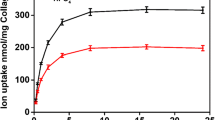Abstract
Previous studies have implicated ferric ion bound to matrix sulfhydryl as the nucleating species inducing the deposition of hydroxyapatite in elastic tissuein vitro. In this study it was assumed that formation of a mineral phase would block the access of proteolytic enzymes to those regions of the matrix involved in nucleation and binding of mineral, while nonessential portions of the matrix would be removed. Mineral was found to be concentrated in the residue after proteolysis. The cysteine content as determined by cysteic acid of the residue left after elastase treatment of calcified “elastin” was five times that of the residue from uncalcified elastin. The cysteine content of the residue protected by mineral was highest during the nucleation phase. Fe3+ was also found to be concentrated in the calcified residue after digestion. The data indicated that one mole of iron was bound per mole of cysteine sulfhydryl. It is postulated that iron bound to matrix cysteine is at the nucleation site in elastic tissue.
Résumé
Des études précédentes ont indiqué que l'ion ferrique lié a la matrice sulphydryle est le corp initiateur d'un dépot d'hydroxyapatite dans les tissus élastiquesin vitro. Dans cette étude il fut assumé que la fermation d'une phase minérale empecherait l'accès des enzymes protéolytiques dans ces régions de la matrice qui opérent la liaison du minéral trandis que des régions non essentielles de la matrice seraient enlevées. Le minéral a été trouvé concentré dans le résidu après protéolyse. Le contenu cystéine détermine par l'acide cystique du résidu après le traitement élastase de l'elastine calcifiée était 5, fois plus grand que le residu de l'élastine non calcifiée. Le contenu cystéine du résidu protégé par le minéral était le plus important durant la période initiatrice. Il fut aussi découvert que Fe3+ était concentré dans le residu calcifié après digestion. Les données de cette recherche indiquaient qu'un mole de fer se liait à un mole de cystéine sulfhydryle. L'hypothése est que le fer lié à la matrice cystéine se trouve au siège initiateur dans le tissu élastique.
Zusammenfassung
Früherein vitro-Untersuchungen legten die Vermutung nahe, daß das an die Sulfhydrylgruppen der Matrix gebundene Eisen der Keimbildner für die Hydroxylapatitablagerung in elastischem Gewebe ist. In diesen Untersuchungen wurde angenommen, daß die Bildung einer mineralischen Phase die Regionen der Matrix, die an der Keimbildung und Bindung des Minerals beteiligt sind, dem Zugang proteolytischer Enzyme entzieht, während die unwichtigen Bereiche der Matrix abgebaut werden. Das Mineral war nach der Proteolyse im verbleibenden Rückstand angereichert. Der Cysteingehalt (bestimmt als Cysteinsäure) im Rückstand der Elastasebehandlung von „calcifiziertem” Elastin ist 5mal größer als der von „nichtcalcifiziertem” Elastin. Der Cysteingehalt des vom Mineral geschützten Matrixteiles war während der Keimbildungsphase am höchsten. Fe3+-Ionen waren nach der Enzymbehandlung im Rückstand angereichert. Die Werte zeigen, daß 1 Mol Eisen auf 1 Mol Cysteinschwefel entfällt. Es wird angenommen, daß das Eisen während der Keimbildung in elastischem Gewebe an das Cystein der Matrix gebunden wird.
Similar content being viewed by others
References
Anfinsen, C. B., andE. Haber: Studies on reduction and reformation of disulfide bonds. J. biol. Chem.236, 1361–1363 (1963).
Brown, W. E., in: Proceedings of the First Conference on Biology of, Hard Tissue, p. 60, ed.Ann M. Budy. New York: N.Y. Acad. Sci. 1967.
Eisenstein, R., R. E. Trueheart, andG. M. Hass, in: Calcification in biological systems, p. 281, ed.R. F. Sognaess, American Association for the Advancement of Science, Washington, D. C., 1960.
Fleisch, H.: Role of nucleation and inhibition in calcification. Clin. Orthop.32, 170–180 (1964).
—, andW. F. Neuman: Mechanisms of calcification: role of collagen polyphosphates, and phosphatase. Amer. J. Physiol.200, 1296–1299 (1961).
Graddon, D. P.: Introduction to coordination chemistry. New York: Pergamon Press 1961.
Linke, W. F.: Solubilities of inorganic and organic compounds, 4th ed., p. 1037. Princeton: D. Van Nostrand, Inc., 1958.
Martin, G. R., E. Schiffmann, H. A. Bladen, andMarie, Nylen: Chemical and morphological studies on thein vitro calcification of the aorta. J. Cell Biol.16, 243–252 (1963).
Miller, E. J., andH. Fullmer: Elastin: diminished reactivity with aldehyde reagents. J. exp. Med.123, 1097–1108 (1966).
—, andK. A. Piez: Accelerated single-column procedure for the automatic analysis of amino acids in collagen and elastin hydrolysates. Anal. Biochem.16, 320–323 (1966).
Moore, S.: On the determination of cystine as cysteic acid. J. biol. Chem.238, 235–237 (1963).
Partridge, S. M., D. F. Elsden, andJ. Thomas: Constitution of cross-linkages in elastin. Nature (Lond.)197, 1297–1298 (1963).
Schiffmann, E., Barbara A. Corcoran, andG. R. Martin: Role of complexed heavy metals in initiating the mineralization of “elastin” and the precipitation of mineral from solution. Arch. Biochem.115, 87–94 (1966).
—,G. R. Martin, andB. A. Corcoran: The role of the matrix in aortic calcification. Arch. Biochem.107, 284–291 (1964).
Sillén, L. G., andA. E. Martell: Stability constants of metal-ion complexes. Special Publ. No 17. London: The Chemical Society 1964.
Sobel, A. E., M. Burger, andS. Nobel: Mechanisms of nuclei formation in mineralizing tissues. Clin. Orthop.17, 103–123 (1960).
Solomons, C. C., J. T. Irving andW. F. Neumann, in: Calcification in biological systems, p. 203, ed.R. F. Sognnaes, American Association for the Advancement of Science, Washington,, D. C., 1960.
Walton, A. G., B. A. Friedman, andA. Schwartz: Nucleation and mineralization of organic matrices J. Biomed. Mater. Res.1, 337–354 (1967).
Author information
Authors and Affiliations
Rights and permissions
About this article
Cite this article
Schiffmann, E., Lavender, D.R., Miller, E.J. et al. Amino acids at the nucleating site in mineralizing elastic tissue. Calc. Tis Res. 3, 125–135 (1969). https://doi.org/10.1007/BF02058655
Received:
Issue Date:
DOI: https://doi.org/10.1007/BF02058655




